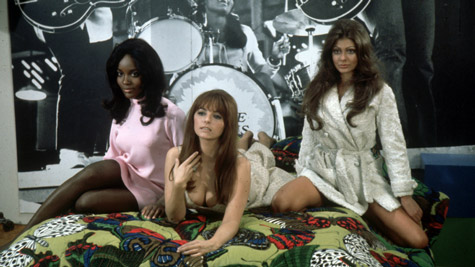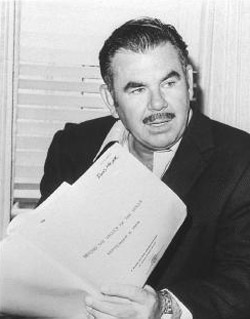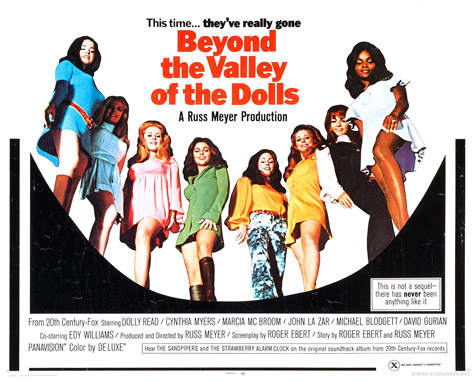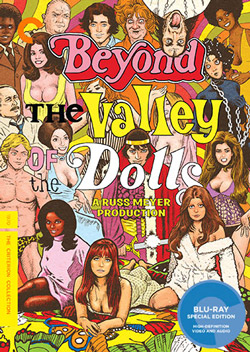
Criterion’s new Blu-Ray edition of Russ Meyer’s 1970 film Beyond the Valley of the Dolls gives me a prompt to write about a movie that I treasure. I could try to describe how much I like the film, but it might be easier and more telling if I just mention how many times I’ve watched it: I estimate 10-12 start-to-finish viewings, in addition to innumerable re-watches of individual scenes. I own the (glorious) soundtrack on vinyl, and it’s never but so far away from my turntable’s needle.
When people see BTVOTD for the first time, many of them (this was true of me, for sure) feel the need to start it back up and watch it again. There are so many dizzying cuts in the film, such a barrage of zinging one-liners, that on first viewing, it can be a sort of pleasurable assault on the your’s senses that leaves you feeling like you only really took in a portion of what happened and need to cue it back up to get what you missed.
The backstory behind the movie is rich. The higher-ups at 20th Century Fox were looking to release a sequel to the 1967 film Valley of the Dolls, which was based on the Jacqueline Susann novel and, athough highly successful financially, was mostly panned by critics. Fox wasn’t after Oscars with the remake, but they did want the same kind of high-dollar return they got on the ’67 title. Also, given the fact that it was 1969 when the movie was being planned, they wanted to come off as having a hip, underground quality to their studio.
 So they hired Russ Meyer—a former WWII cinematographer and nudie pinup photographer who had been making independent softcore sex films for the past decade or so—to direct. The studio was drawn to Meyer largely because of the ridiculously large profit he’d turned on his 1968 release, Vixen, a drive-in favorite that cost Meyer relatively little to make and brought in millions.
So they hired Russ Meyer—a former WWII cinematographer and nudie pinup photographer who had been making independent softcore sex films for the past decade or so—to direct. The studio was drawn to Meyer largely because of the ridiculously large profit he’d turned on his 1968 release, Vixen, a drive-in favorite that cost Meyer relatively little to make and brought in millions.
Meyer had been doing incredibly well in releasing his own films, yet he was ecstatic that a major studio was funding a cinematic project of his. He got his friend Roger Ebert, then a young film journalist based in Chicago, to take a leave of absence from his day job and come out to L.A. to help him conceive of the story and write its screenplay. What they created is one of the most unique and wild scripts in the history of Hollywood.
If anyone thinks that the distinguished Ebert later wanted to forget his participation in the making of the bizarre movie, just watch the interviews with him in the extras that come with this Criterion package, and you will see that he was (a) genuinely and highly appreciative of Meyer as a filmmaker and (b) immensely proud of BTVOTD and his part in its creation. What 20th Century Fox thought of the film is another matter: despite the fact that it did as they wanted and made a ton of money for them, they have always treated it as something shameful that should be swept under the rug.
Meyer was too strong-headed and too much of a visionary to make a straight sequel to the Susann story. That was never going to happen. With Ebert’s help, he took that film’s premise—three young women in the performing arts who come to Hollywood and see their lives become messed up in a variety of ways—and took it places that left the Valley of the Dolls story looking dull by comparison.

Meyer and Ebert devised a tale of a young female rock trio—The Carrie Nations—who go from playing high school proms in Nowheresville to relocating to L.A. and becoming pop sensations. The story is about all the freaky people that come into their lives as they rise to the top and how they are threatened in various ways by the turmoil that can come with popular success in show business.
Like most Meyer films, it’s a comedy that’s played straight by its cast. It’s a satire. And, since Meyer was famously obsessed with very large breasts, it’s also a big titty parade. Like Meyer’s other sexy cinematic fare, it also has bits of melodrama, often so overblown as to bring out hearty chuckles from viewers. There’s a cartoon-y feel to this and many Meyer films.
Susann was not amused by the movie. Despite the fact that there are titles during the opening that state that the film is not a sequel to Valley of the Dolls and has no real relation to it, the bestselling author felt that BTVOTD sullied her reputation by association, and she successfully sued.
I could get lost in attempting to comment on all the major characters in the movie and/or the most memorable lines and scenes and such. So, I won’t try. Anybody reading this who doesn’t know about all of that already, should see the movie for the first time not knowing too much about it—let it all be a delirious surprise.
The story is the product of two decidedly un-hip dudes—Meyer and Ebert—writing in a wide open, exuberant way about Hollywood and music biz scenesters. The makes-your-head-spin look and feel of the movie is the result of Meyer’s unique approach to shots and cuts. The outrageous characters are similar to those found in Meyer’s other films. It’s a romp. Anyone who sees it is likely to come away either loving or loathing it—this film does not evoke tepid responses.
 The extras that come with the new Criterion issue of BTVOTD are a bottomless treasure that will thrill fans of Meyer and of this film in particular. There are too many bonus features for me to comment on each of them individually, so I’ll just present an overview of what’s in the set: there are documentaries on Meyer and BTVOTD specifically; tons of interview segments with Meyer, Ebert, and cast members; audio commentary from various key people behind the film; footage of screen tests from some of the actors; trailers . . . it’s just a massive bunch of Russ Meyer and BTVOTD goodness.
The extras that come with the new Criterion issue of BTVOTD are a bottomless treasure that will thrill fans of Meyer and of this film in particular. There are too many bonus features for me to comment on each of them individually, so I’ll just present an overview of what’s in the set: there are documentaries on Meyer and BTVOTD specifically; tons of interview segments with Meyer, Ebert, and cast members; audio commentary from various key people behind the film; footage of screen tests from some of the actors; trailers . . . it’s just a massive bunch of Russ Meyer and BTVOTD goodness.
If I have one gripe about the full package, it’s that I didn’t find either of the two essays inside the booklet to be particularly insightful or enjoyable to read. But that’s a quibble, and the quality level of the booklet doesn’t take away from the rapturous joy I experienced in watching this movie again and taking in all the bonus features.
To learn more or order a copy, visit:
opens in a new window![]() opens in a new window
opens in a new window![]()
Brian Greene writes short stories, personal essays, and reviews and articles of/on books, music, and film. His work has appeared in 25+ publications since 2008. His pieces on crime fiction have also been published by Noir Originals, Crime Time, Paperback Parade, The Life Sentence, Stark House Press, and Mulholland Books. Brian lives in Durham, North Carolina.
His writing blog can be found at: http://briangreenewriter.blogspot.com. Follow Brian on Twitter @greenes_circles

Great piece, Brian. I plan to watch the movie asap.
Thanks, Eric! The movie’s a romp. You won’t be disappointed.
“But Gordonstoun developed my willpower and self control, helped me to discipline myself… We went in for ‘adventure’.